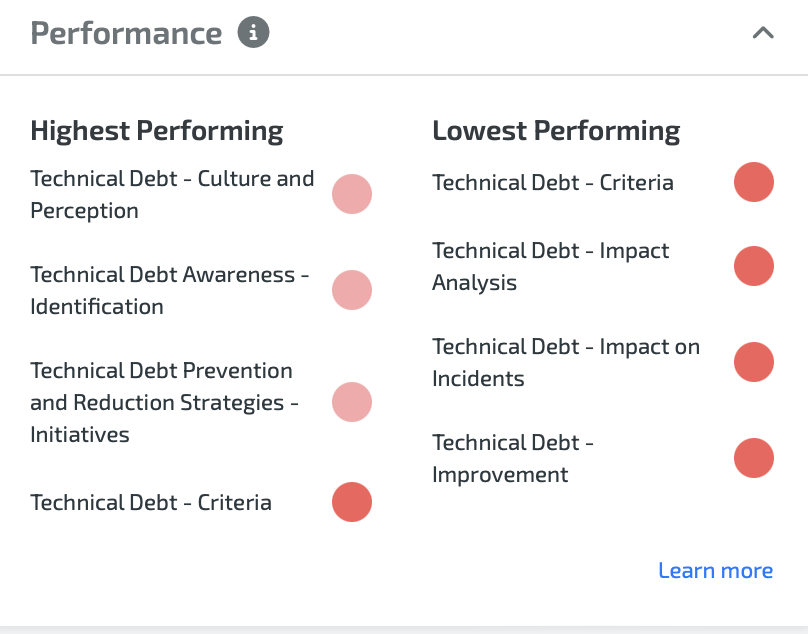Leaders today face unique opportunities, marked by the twin challenges of recession and cost constraints, the agility of a business is not just a competitive advantage but a necessity for survival. CEOs are facing the daunting task of slashing costs while also maintaining the flexibility and responsiveness essential in a rapidly changing market. Amidst these pressures, a critical yet often overlooked factor plays a pivotal role: technical debt. This concept, frequently underestimated, has far-reaching implications on a company’s capacity to deliver value efficiently. In this blog post, we will delve into the definition of technical debt and examine its intricate connection with business agility and cost management. Further, we will explore how adopting a growth mindset can transform the way organizations perceive and handle technical debt, leading to enhanced innovation, quality, and adaptability. By aligning technical debt management with a growth-oriented approach, businesses can foster environments that not only mitigate risks but also propel continuous improvement and learning.
Defining Technical Debt:
Technical debt is a metaphor coined by Ward Cunningham, a renowned software developer and co-author of the “Agile Manifesto for Software Development”. Ward describes the trade-off between short-term benefits and long-term consequences in software development. It refers to the accumulation of suboptimal or hasty design and coding choices made during the development process. These shortcuts, while expedient in the short term, create a “debt” that must be paid off in the future. Just as financial debt accrues interest, technical debt accumulates hidden costs over time, hindering a company’s ability to adapt and innovate.
The Relationship Between Technical Debt and Business Agility:
- Slows Down Innovation: Technical debt can impede a company’s ability to innovate swiftly. As outdated or inefficient code accumulates, it becomes increasingly challenging to implement new features, adapt to market changes, or respond to emerging opportunities. This slows down a company’s response to customer needs and market dynamics.
- Increases Maintenance Costs: Over time, technical debt becomes a drag on productivity and efficiency. Developers spend more time fixing bugs, addressing issues, and maintaining the existing codebase rather than working on new features or improvements. This increased maintenance overhead can lead to rising costs.
- Decreases Flexibility: Technical debt can make systems and processes rigid and inflexible. In an era where adaptability is paramount, having a rigid technical foundation can hinder a company’s ability to pivot, scale, or explore new avenues quickly.
- Harms Customer Experience: Poorly maintained or inefficient software can result in a subpar customer experience. This can lead to customer churn, increased support costs, and damage to the company’s reputation—all of which negatively impact the bottom line.
Cost Control and Reducing Technical Debt:
Addressing technical debt is crucial for effective cost control in the face of a recession. While tackling technical debt does require an initial investment of time and resources, it pays off in the long run by reducing the hidden costs associated with inefficiencies, maintenance, and lost opportunities. Here are steps to consider:
- Prioritize Debt Reduction: Identify areas of your technical infrastructure that have accrued the most debt and prioritize them for improvement.
- Allocate Resources: Dedicate time and resources to addressing technical debt as part of your development process. This might involve refactoring code, revising architecture, or implementing best practices.
- Continuous Improvement: Cultivate a culture of continuous improvement within your development teams. Encourage them to address technical debt as they encounter it rather than accumulating it.
- Measure Impact: Track the impact of technical debt reduction efforts by monitoring improvements in development speed, bug rates, customer satisfaction, and overall operational efficiency.
Four Behaviours for Addressing Technical Debt:
At Tactec we have created a goal driven model to assess, focus and deliver tangible benefits by applying the following areas for a “growth mindset” these help bring about real change. To introduce a qualitative approach the growth mindset these four dimensions around behaviours and practices:
Value Driven
- Awareness – Identification: This dimension emphasizes the crucial first step in managing technical debt: awareness and identification. By equipping teams with the right insights and tools, organizations can ensure that technical debt is not just recognized but also understood in terms of its nature and implications. This involves training, workshops, and implementing tools that can detect and quantify technical debt.
- Criteria: Setting clear criteria for assessing the severity and impact of technical debt enables organizations to prioritize effectively. This involves creating a framework to evaluate technical debt based on factors like risk, cost, and impact on business objectives. Prioritization ensures that resources are allocated efficiently to address the most critical debts first.
Dynamics
- Culture and Perception: This aspect explores the role of organizational culture in both the accumulation and management of technical debt. It involves fostering a culture where technical debt is openly discussed and treated as an important factor in strategic decision-making, rather than being seen as a mere technical issue.
- Psychological Safety: Creating an environment of psychological safety is key to enabling team members to raise concerns and propose solutions regarding technical debt. This entails establishing a non-punitive culture where learning from mistakes is valued over blame.
Quality
- Initiatives: This focuses on the proactive aspect of managing technical debt. It involves implementing initiatives such as code reviews, refactoring, and adopting new technologies or practices that can prevent the accumulation of new debt and reduce existing debt.
- Impact on Incidents: Understanding how technical debt contributes to operational incidents is crucial. This involves analyzing past incidents to identify the role of technical debt and using this data to inform future strategies to enhance quality and reliability.
Adapt
- Impact Analysis: This involves a thorough analysis of how technical debt affects various areas of business, including agility, scalability, and innovation. It’s about understanding the long-term effects of technical debt on business operations.
- Practices: Here, the focus is on sharing and implementing best practices for managing technical debt. This includes adopting agile practices, continuous integration and delivery, and regular debt reviews to ensure the organization adapts and stays ahead of potential issues.Incorporating these dimensions into your technical debt assessment model aligns well with a growth mindset, as it promotes continuous learning, improvement, and adaptation. By addressing technical debt through these lenses, organizations can not only mitigate risks but also create opportunities for innovation and enhanced business agility.
Conclusion: You can continue to transform and reduce costs
In today’s economy, where every decision counts double due to the pressures of cost control and the need for business agility, effectively managing technical debt becomes not just a wise choice, but a strategic necessity. Tackling technical debt is an investment that yields both immediate and long-term benefits, enabling businesses to stay agile, reduce ongoing maintenance costs, and adeptly navigate the ever-shifting market landscape. This approach is key to empowering CEOs to combat escalating costs while laying the groundwork for their organizations’ enduring success.
Are you ready to embark on this transformative journey? Click below for a complimentary, concise assessment and a personalized report, brought to you in collaboration with our partner, Lean Agile Intelligence. At Tactec, we excel in assisting businesses to pinpoint, quantify, and monitor the results of their technical debt management strategies. Our team of seasoned professionals is committed to guiding you every step of the way, offering bespoke insights and solutions that resonate with your specific organizational needs. Use the link to access our DevOps book that provides insightful ways to achieve a level of maturity for DevOps that tackles technical Debt.
The time to act is now! Reach out to us via our easy-to-use contact form or give us a call for a no-obligation consultation. Begin your venture towards enhanced business agility and effective cost management with the support of Tactec and leanagileintelligence.com. Your future of streamlined operations and strategic foresight awaits.










